(part two of a three-part series)
USS Tennessee (BB-43)
Commissioned in 1920, USS Tennessee was the leadship of a two-vessel class, the other being USS California.
 (USS Tennessee before WWII.)
(USS Tennessee before WWII.)
The attack
USS Tennessee was at station F-6, inboard of USS West Virginia and ahead of USS Arizona. USS Tennessee was struck by two bombs. The first hit the centreline 14″ gun of “B” turret, rendering that gun inoperable. Shrapnel from this bomb flew into the bridge of USS West Virginia, fatally wounding that battleship’s captain. The second bomb hit “X” turret’s roof, going through the seaplane catapult and damaging the turret, in addition to destroying it’s rangefinder. USS Tennessee was also struck by burning debris from the explosion of USS Arizona, which started a significant fire aft. The fire from the USS Arizona debris was actually the main cause of damage aboard USS Tennessee. As a precaution, both aft main magazines were flooded by the crew. One of the battleship’s motorboats was destroyed either by strafing or bomb fragments, and another was launched but sank in the harbor after burning fuel from USS Arizona set it on fire.
During the attack, the engine room lit off the boilers and USS Tennessee turned her propellers at a very low rpm to create a current pushing away fuel leaking out of USS Arizona. It was impossible for the battleship to sortie like USS Nevada had, because the sunken USS West Virginia had USS Tennessee pinned against the mooring quays.
 (Several hours after the attack, the wreck of USS Arizona burns in the foreground while ahead, USS Tennessee slowly churns the water to push USS Arizona’s leaking fuel away. The spouts of water coming out of USS Tennessee are the overflow relief valves of the aft magazine flooding system.)
(Several hours after the attack, the wreck of USS Arizona burns in the foreground while ahead, USS Tennessee slowly churns the water to push USS Arizona’s leaking fuel away. The spouts of water coming out of USS Tennessee are the overflow relief valves of the aft magazine flooding system.)
The battleship’s three seaplanes were ashore on the Ford Island apron when the attack happened. All were destroyed on the ground.
At 18:00, eight hours after the attack had ended, another fire broke on USS Tennessee, in the lubrication system for the ship’s crane. It is thought that this was caused simply by heat off the USS Arizona fire building up over the day.
 (USS Tennessee on 10 December 1941, three days after the attack, pinned against her mooring quays by the sunk USS West Virginia outboard.)
(USS Tennessee on 10 December 1941, three days after the attack, pinned against her mooring quays by the sunk USS West Virginia outboard.)
Repairs and WWII
Although the fire damage was significant, USS Tennessee was in better shape than most of the other battleships. At 00:00 on 8 December 1941, it was reported that the centreline gun of “B” turret and all three guns of “X” turret were out of commission, as were the aviation facilities. Once the aft magazines were dewatered, the battleship would have eight of her twelve 14″ main guns available. All secondary and AA guns were operational but needed more ammunition (USS Tennessee fired 760 5″ rounds and 4,180 smaller rounds). The propulsion, electrical, and navigation systems were intact and the battleship was 94% fueled.

The biggest hurdle was USS West Virginia, which was pinning in USS Tennessee. After the two battleships were separated, USS Tennessee proceeded to Puget Sound Naval Shipyard, WA for repairs.
Inspection of the ship showed damage more severe than originally thought. Much of the communications wiring aft was wrecked. In the hull, there was a total of 500′ of seams that were warped apart, presumably from the intense heat of USS Arizona‘s fuel burning alongside. About 700 rivets needed to be replaced. A 40’x14’ dent was discovered below the waterline, caused by USS West Virginia.
Like many of the Pearl Harbor battleships, USS Tennessee was repaired and refitted in two phases. The immediate repair period at Puget Sound lasted until February 1942. The aft mast was removed, and more modern 5″ guns were added. USS Tennessee fought the Aleutians campaign like this.
From August 1942-May 1943, the battleship was completely rebuilt, looking almost nothing like it did in 1941. The superstructure was completely rebuilt, radar was installed, and more AA guns were installed.
 (The completely rebuilt USS Tennessee in July 1945, towards the end of WWII.)
(The completely rebuilt USS Tennessee in July 1945, towards the end of WWII.)
After this second rebuild, USS Tennessee fought in almost all of the major Pacific battles: the Marshalls campaign, the Marianas, Palau, Leyte Gulf, Iwo Jima, and Okinawa. USS Tennessee finished the war as part of a surface action group sweeping the seas between China and Japan.
USS Tennessee after WWII
The first post-WWII assignment for USS Tennessee was to support the landing of occupation troops at Wakayama on 25 September 1945. After this mission, USS Tennessee docked at the former Imperial Navy shipyard at Yokosuka to help establish the occupation force there.
In late October 1945, USS Tennessee made a flag-showing visit to Singapore, where the British were re-establishing control. This was followed by a cruise of the southern Indian Ocean, passing South Africa and then northbound to the USA.
On 7 December 1945, the fourth anniversary of the attack, USS Tennessee docked at Philadelphia, PA. It was the ship’s first visit to the eastern seaboard since before WWII.
 (USS Tennessee on 7 December 1945, the first post-WWII anniversary of the attack.)
(USS Tennessee on 7 December 1945, the first post-WWII anniversary of the attack.)
After a crew stand-down for Christmas and New Years, work began on inactivation of USS Tennessee. The US Navy had already decided in 1945 not to retain the ship on active commission in the peacetime navy. Throughout the spring of 1946, USS Tennessee remained on active duty but with a gradually reduced crew as wartime enlistments ended.
In May 1946, the preliminary steps of the inactivation were done and the battleship entered Drydock #5 at Philadelphia, nestled in with her sister-ship USS California.
 (Philadelphia Naval Shipyard in late summer 1946. The warships are 1) USS Tennessee 2) her sister-ship USS California (BB-44) 3) the battleship USS South Dakota (BB-57) 4) the cruiser USS Olympia (IX-40) 5) the British frigate HMS Rupert 6) the cruiser USS Detroit (CL-8) 7) the cruiser USS Trenton (CL-11) 8) the British frigate HMS Berry. The British ships had to be returned to the USA under Lend-Lease law; they were quickly scrapped. The two cruisers were obsolete and scrapped within two years. The three battleships were scrapped years later. As of 2015, the only ship pictured still in existence is USS Olympia, Commodore Dewey’s flagship during the Spanish-American War, now a museum ship. Of interest is the two white cylinders on the pier. Some naval historians think they were barbettes intended for the cancelled Iowa-class battleship USS Illinois (BB-65) while others think they are spare barbettes for USS Tennessee. In either case they were being lined up for scrapping.)
(Philadelphia Naval Shipyard in late summer 1946. The warships are 1) USS Tennessee 2) her sister-ship USS California (BB-44) 3) the battleship USS South Dakota (BB-57) 4) the cruiser USS Olympia (IX-40) 5) the British frigate HMS Rupert 6) the cruiser USS Detroit (CL-8) 7) the cruiser USS Trenton (CL-11) 8) the British frigate HMS Berry. The British ships had to be returned to the USA under Lend-Lease law; they were quickly scrapped. The two cruisers were obsolete and scrapped within two years. The three battleships were scrapped years later. As of 2015, the only ship pictured still in existence is USS Olympia, Commodore Dewey’s flagship during the Spanish-American War, now a museum ship. Of interest is the two white cylinders on the pier. Some naval historians think they were barbettes intended for the cancelled Iowa-class battleship USS Illinois (BB-65) while others think they are spare barbettes for USS Tennessee. In either case they were being lined up for scrapping.)
During the drydocking, all fittings below the waterline were sealed shut. All of the light (20mm and below) guns were moved ashore. The 40mm mounts were encased in blown plastic or covered with “igloos”, and the 5″ and 14″ guns were sealed. The bridge windows were boarded up, and the engines drained.
 (USS Tennessee being mothballed in May 1946. The 40mm mounts are covered with “igloos” or encased in blown plastic. Gunshields for the 20mm guns are on the railroad flatbed on the pier. The battleship’s liferafts are stacked on the quarterdeck, awaiting warehouse storage ashore. The bow of USS California is visible next to USS Tennessee in the drydock.)
(USS Tennessee being mothballed in May 1946. The 40mm mounts are covered with “igloos” or encased in blown plastic. Gunshields for the 20mm guns are on the railroad flatbed on the pier. The battleship’s liferafts are stacked on the quarterdeck, awaiting warehouse storage ashore. The bow of USS California is visible next to USS Tennessee in the drydock.)
USS Tennessee was undocked in late summer and moved to a reserve anchorage. Of all the sub-16″ caliber battleships left after WWII, USS Tennessee was perhaps the best in terms of condition and equipment, and the US Marine Corps wanted to keep the old battleship as a reserve gunfire support asset. USS Tennessee formally decommissioned into reserve on 14 February 1947.
During the late 1940s and early 1950s, some of the increasingly obsolete WWII-era radars were removed, either cannibalized for warships reactivating for the Korean War, or warehoused ashore to slow their deterioration.
 (The mothballed USS Tennessee at NISMF Philadelphia on 19 May 1955, moored inboard of USS California (BB-44) and USS Cabot (CVL-28), also both mothballed WWII veterans. In the foreground are two mothballed hospital ships, a nest of mothballed WWII cruisers, and the never-completed USS Hawaii (CB-3) which would have been the third Alaska-class battlecruiser.) (US National Archives photo)
(The mothballed USS Tennessee at NISMF Philadelphia on 19 May 1955, moored inboard of USS California (BB-44) and USS Cabot (CVL-28), also both mothballed WWII veterans. In the foreground are two mothballed hospital ships, a nest of mothballed WWII cruisers, and the never-completed USS Hawaii (CB-3) which would have been the third Alaska-class battlecruiser.) (US National Archives photo)
The Korean War came and went without a reactivation request. By the mid-1950s, it was increasingly clear that the Pearl Harbor veteran would not see further use.
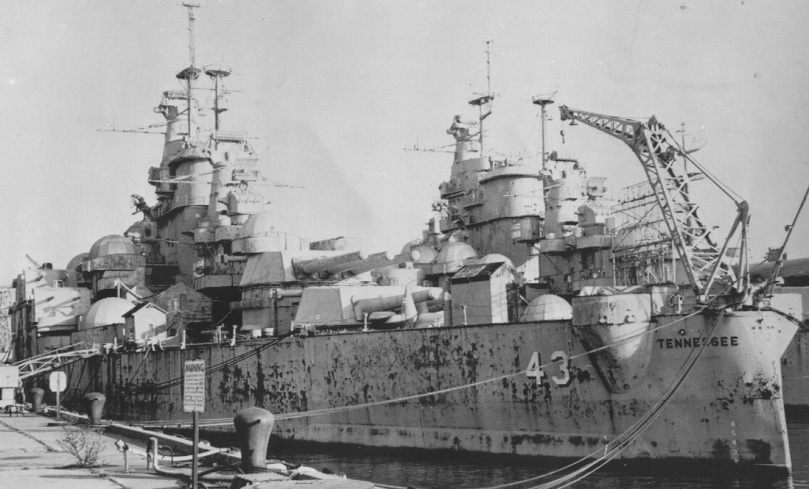 (The mothballed USS Tennessee in December 1956, now starting to rust heavily despite the periodic tending by personnel of Naval Station Philadelphia.)
(The mothballed USS Tennessee in December 1956, now starting to rust heavily despite the periodic tending by personnel of Naval Station Philadelphia.)
Assuming that a properly-mothballed warship ages about ¼ the rate of an active one, USS Tennessee would pass the expected hull lifespan between 1958-1960 anyways. On 1 March 1959, the US Navy formally struck the decommissioned battleship off the reserve rolls and made the hull available for scrap auction. Bethlehem Steel won the auction on 10 July 1959.
 (The ex-USS Tennessee on 11 June 1959. This photo was possibly taken in conjunction with the then-happening scrap auction.)
(The ex-USS Tennessee on 11 June 1959. This photo was possibly taken in conjunction with the then-happening scrap auction.)
Later that year, the ex-USS Tennessee was towed to Baltimore, MD where the hull was broken up by early 1960.
 (The ex-USS Tennessee in late summer 1959, after Bethlehem Steel had towed the old battleship to Baltimore, MD.)
(The ex-USS Tennessee in late summer 1959, after Bethlehem Steel had towed the old battleship to Baltimore, MD.)
 (The former USS Tennessee (left) and USS California (right) being scrapped at Sparrows Point, MD in 1959. Scrapping of USS Tennessee did not finish until 1960, the last of the Pearl Harbor Battleship Row survivors to go.)
(The former USS Tennessee (left) and USS California (right) being scrapped at Sparrows Point, MD in 1959. Scrapping of USS Tennessee did not finish until 1960, the last of the Pearl Harbor Battleship Row survivors to go.)
USS Oklahoma (BB-37)
USS Oklahoma commissioned in 1916 and was the second of the two Nevada-class battleships.
 (USS Oklahoma before WWII.)
(USS Oklahoma before WWII.)
The attack
USS Oklahoma received the worst pounding during the attack. The ship was at position F-5B, tied up outboard of USS Maryland. This happened to be along the main axis of approach for the attacking Japanese planes, and the battleship was an especially easy target. Another bit of bad luck was that USS Oklahoma was scheduled for a hull inspection on Monday morning, and that Sunday most bilge hatches had already been opened.
USS Oklahoma was struck by nine air-dropped torpedoes. All hit port side amidships, and seven of the nine hit a concentrated area about 120′ long beneath the “B” turret and forward superstructure. The eighth hit a bit further aft, and the ninth actually hit the above-decks superstructure as the battleship was in the process of capsizing. It’s believed that one or two bombs hit the battleship as well.
 (USS Oklahoma capsizing during the attack. Behind the rolling hull is USS Maryland and smoke from the burning hangars on Ford Island.)
(USS Oklahoma capsizing during the attack. Behind the rolling hull is USS Maryland and smoke from the burning hangars on Ford Island.)
USS Oklahoma was the first ship struck during the attack. The first two torpedoes hit almost simultaneously at 07:51, with a third at 07:53. By 07:55, USS Oklahoma was already listing 45°, when the fourth torpedo hit; followed by another at 07:57 and another at 07:58, and the others thereafter. Sometime between 07:59 and 08:09, USS Oklahoma capsized. (The deck log of USS Pruitt (DD-347) puts it at 08:10). This happened moments before USS Arizona exploded, and USS Oklahoma is generally regarded as the first battleship sunk in the attack.
The salvage
Righting and refloating USS Oklahoma was a daunting task. The damaged battleship had rolled 135° and was resting on the edge of an underwater embankment, not quite completely upside-down. The fore and aft masts had been ripped off and the superstructure crushed by the battleship’s own weight on top of it.
In the order of salvage priority, USS Oklahoma was placed second-to-last, below USS West Virginia and above the total losses USS Arizona and target ship USS Utah. In preparation, detailed drawings and models were made of USS Oklahoma, including a 1/16 three-level cardboard model.
The first step of raising USS Oklahoma was to drain the fuel aboard. The ship was 100% fueled at the time of the attack with 1,000,000 gallons aboard. Hulls were cut in the capsized bottom to accomplish this.

(Draining holes on the capsized hull being patched on 22 November 1942.)
Because of the capsized ship’s position and the level of damage, it was hard to lighten the vessel as had been done with other sunken battleships. Some structural steel, a bit of machinery, and the propeller blades were cut off. Some 5″ ammunition was offloaded, but it was not possible to safely access any of the heavier 14″ shells.
 (Wreckage off USS Oklahoma being barged away during the summer of 1943.)
(Wreckage off USS Oklahoma being barged away during the summer of 1943.)
In preparation for the righting, 2,200 tons of crushed coral was placed under the bow, so USS Oklahoma would roll on an even surface.
Ashore on Ford Island, a total of 21 concrete-foundation compound pulleys were built, with 1″ steel cables. Each power winch attached to the pulleys had a special meter to gauge the strain on the cable.
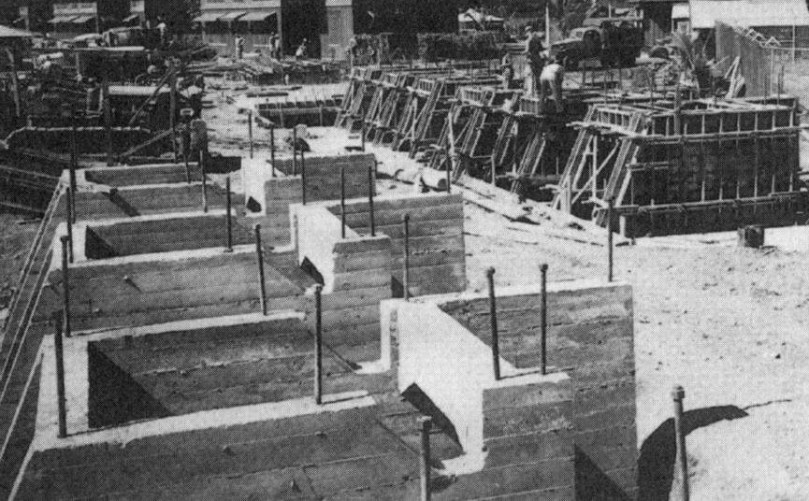 (The pulley foundations being built ashore on 28 October 1942.)
(The pulley foundations being built ashore on 28 October 1942.)
An equal number of frames (called “bents”) were installed on the capsized hull. The bents added additional leverage. The angled leg of each bent was roughly aligned with the battleship’s centre-of-gravity. The cable was split at the end into four points, to spread the load.

 (Above two photos: Installation and position of the bents.)
(Above two photos: Installation and position of the bents.)
The righting process started on 8 March 1943. It was a very slow, gradual process, as not to snap the lines nor destroy the ship. The winches had to be operated gingerly to roll the ship rather than drag it towards shore.
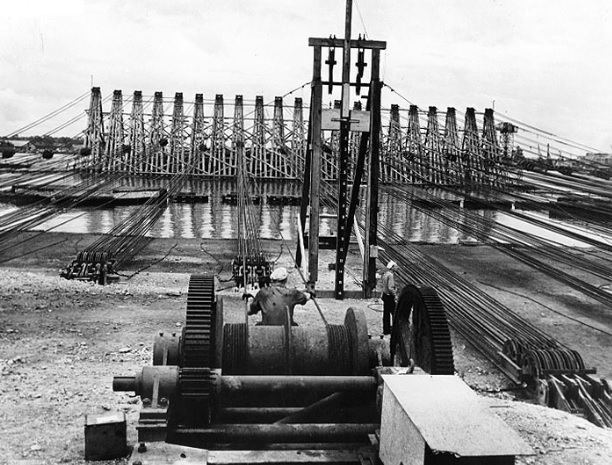
(The righting begins on 8 March 1943.)
 (USS Oklahoma on 19 March 1943, with the bents still on and rolled to about 90°.)
(USS Oklahoma on 19 March 1943, with the bents still on and rolled to about 90°.)
When USS Oklahoma was rolled to 90° the bents began to lose their leverage effect and when the ship had been rolled to 68°, they were removed. The cables were then attached to lugs welded directly onto the hull. When USS Oklahoma had been rolled to 30°, the lines were removed from the lugs and wrapped around topside features such as the main gun turrets.
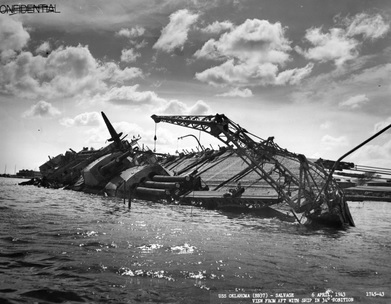
(USS Oklahoma in June 1943, rolled to 34°.)


(The rolling process continued, now with the cables wrapped around the main turrets.)
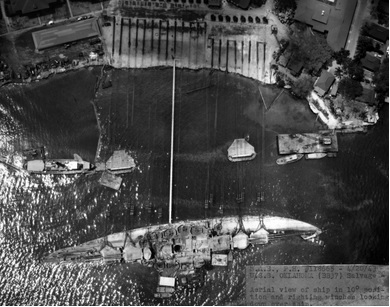
(USS Oklahoma rolled to 10° during the summer of 1943.)
The rolling process completed on 16 June 1943. Righting such a huge capsized vessel with ashore machinery was a tremendous engineering feat, not really repeated again until the recovery of the cruise ship Costa Concordia in 2014.

(USS Oklahoma completely righted but still sunk.)
Once righted, USS Oklahoma sat at a 2° list to port, with the weather deck barely clear of the water. The next step was to make the battleship buoyant enough to again move. A 130’x57′ patch made of wood and tremie (underwater concrete) was affixed to the most heavily damaged area amidships. Tremie was also used to plug smaller or awkward holes. Meanwhile everything possible to lighten the ship was done. All of the wreckage above the main deck was cut off, and the 14″ shells offloaded. A copious amount of H²S gas had to be cleared from the interior. Divers were sent inside the ship to begin closing watertight doors, opening and closing drain valves, etc. to ease the upcoming dewatering process. This was a difficult task as during the 19 months the ship was capsized, a large amount of mud and jellied fuel oil had accumulated inside.
On 3 November 1943, the righted USS Oklahoma finally floated just clear of the bottom. The battleship was intentionally given a 1 ½° starboard list to ease pressure on the port side patch. Now again afloat, more lightening was done. The anchors and their chains were offloaded, and more pumps brought in to force out mud and jellied fuel oil.
 (USS Oklahoma again afloat in December 1943, two years after being sunk.)
(USS Oklahoma again afloat in December 1943, two years after being sunk.)
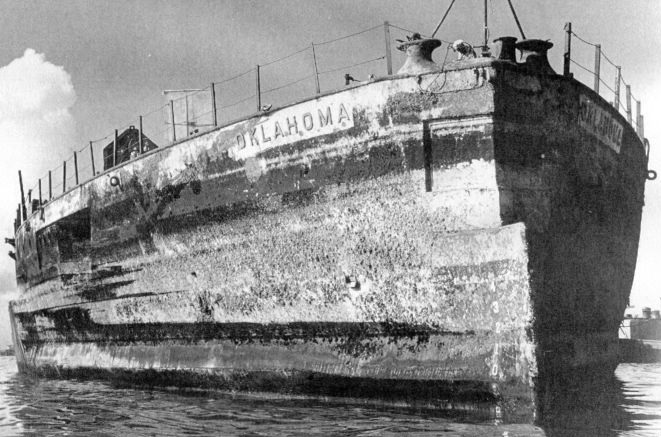 (The barnacle-encrusted hull after the stern seaplane crane was removed in December 1943.)
(The barnacle-encrusted hull after the stern seaplane crane was removed in December 1943.)
On 28 December 1943, two years and eleven days after sinking, USS Oklahoma was sturdy enough to be pushed to the other side of the harbor and drydocked. The battleship was drydocked at an intentional 3° angle to ease access to the damaged side. Once the drydock was drained, the full scope of the torpedo damage could be seen. Obviously, if USS Oklahoma were to be repaired, it would be a colossal task.
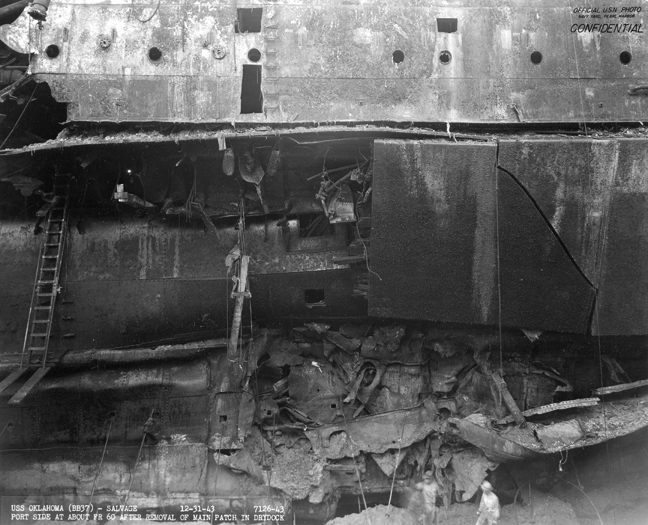 (USS Oklahoma in drydock on 31 December 1943, showing one of the torpedo hits. One of the heavy steel plates of the battleship’s armor belt shows a stress fracture, either from the explosions or from the capsizing.)
(USS Oklahoma in drydock on 31 December 1943, showing one of the torpedo hits. One of the heavy steel plates of the battleship’s armor belt shows a stress fracture, either from the explosions or from the capsizing.)
Decision regarding repairs
USS Oklahoma remained drydocked for several months. The patch was removed and some machinery taken ashore along with the guns. At each step, additional damage was discovered.
 (The massively damaged USS Oklahoma in January 1944. The rock-like debris in the drydock is the tremie used in the patches.)
(The massively damaged USS Oklahoma in January 1944. The rock-like debris in the drydock is the tremie used in the patches.)
In late 1943, it was decided to “defer” further repairs. The battleship was patched up enough to be easily movable by tugs, and then parked in an out-of-the-way place at Pearl Harbor Naval Shipyard.
This limbo lasted for about a year. In August 1944, a final decision was made not to restore the ship to service. USS Oklahoma was formally decommissioned on 1 September 1944. There were three main points considered:
- In the overall naval balance, the USA lost two battleships (USS Arizona and USS Oklahoma) on 7 December 1941, but afterwards had repaired all the other attack victims and built seven more battleships, with three more (USS Wisconsin and the never-completed USS Illinois and USS Kentucky) still building. Meanwhile no additional American battleship had been lost. This was compared to the Imperial Japanese Navy, which had lost five battleships since 7 December 1941, built only two, and had zero under construction.
- The repair of USS West Virginia was more difficult and expensive than anticipated. With USS Oklahoma even more severely damaged, repairs were judged to be an order of magnitude harder.
- During the second part of WWII, a small team in the US Navy began planning what the postwar fleet would look like. This was kept quiet as not to seem flip while Americans sailors were still dying. It had already been decided that, regardless of any losses in the remainder of the war, all “Newport”- or “Standard”-style battleships would be decommissioned. These were the Wyoming, New York, Nevada, Pennsylvania, New Mexico, Tennessee and Colorado classes. With no knowledge of the Manhattan Project, the team estimated that WWII would end sometime in the summer or autumn of 1946. Judging USS Oklahoma‘s damage and the shipyard experiences with USS West Virginia, it was estimated that repairs would take 14 months, with the battleship then decommissioning in less time than that anyways in 1946.
 (An excellent picture of the march of technology; on 11 November 1944 the new modern battleship USS Wisconsin next to USS Oklahoma’s hull at Pearl Harbor. Only two decades separated the designs but they may as well have been from different planets.)
(An excellent picture of the march of technology; on 11 November 1944 the new modern battleship USS Wisconsin next to USS Oklahoma’s hull at Pearl Harbor. Only two decades separated the designs but they may as well have been from different planets.)
The hulk was patched shut with temporary wooden structures. The ex-USS Oklahoma sat idle for the remainder of WWII. The salvage had been (at that time) the most expensive of the US Navy’s history, and in the end it was for nothing.
USS Oklahoma after WWII
Nothing was done with the decommissioned ship for most of 1946. Late in the year, the hulk was made available for scrap auction. On 5 December 1946, Moore Drydock of Oakland, CA purchased the hulk. The company intended to scrap it in the mainland USA.
 (The ex-USS Oklahoma in January 1947. Crude wood and canvas covers were built over the main gun barbettes and boiler exhausts after salvage work had ceased, to preserve what remained of the old battleship for scrap value.)
(The ex-USS Oklahoma in January 1947. Crude wood and canvas covers were built over the main gun barbettes and boiler exhausts after salvage work had ceased, to preserve what remained of the old battleship for scrap value.)
In May 1947, the civilian tugboats Monarch and Hercules towed the ex-USS Oklahoma out of Pearl Harbor, the first time it had moved out of the base since 1941. It was intended to tow the hulk to San Francisco, CA.
 (The ex-USS Oklahoma at Pearl Harbor during the summer of 1947.)
(The ex-USS Oklahoma at Pearl Harbor during the summer of 1947.)
On 17 May 1947, about 500 NM northeast of Hawaii, the tow line snapped during a storm. The two tugs tried to recover the unmanned hulk but before they could do so, it sank.

(The final photo of the ex-USS Oklahoma, minutes before the hulk sank.)
In 2006, the US Navy dredged the former Battleship Row area of Pearl Harbor and recovered a large piece of USS Oklahoma which had been torn off during the capsizing. It was the rear port-side leg of the aft tripod mast. The large artifact was donated to the state of Oklahoma.

[…] Source: Pearl Harbor battleships after WWII: part II […]
LikeLike
It’s great having all the information in one place. Most sites (mine included) skim over the data or just focus on one ship. Excellent job!
LikeLike
Thank you, I used to be stationed out at Pearl in the mid/late 1990s and always wondered what happened to the ships; all the history books either stop mentioning them after Dec 7th or after the war ends. There is still a lot of WWII stuff on base (or at least there was in the 1990s).
LikeLiked by 1 person
You’ve done a great job!
LikeLike
I echo “thanks” to you for covering the wreck/salvage/removal of the big ships in Pearl Harbor. I can attest to the remarkable parbuckling (vessel righting) engineering feats, as I was on the combined US/Italian consortium involved in floating the Costa Concordia, in Isola Del Giglio, Italy. Way more intricate and involved than one might think.
LikeLiked by 2 people
An excellent article that sates quite a bit of long-held curiosity.
The section of mast from the U.S.S. Oklahoma recovered in 2006 currently resides in Muskogee, Oklahoma, in a pavilion located near the museum submarine U.S.S. Batfish.
LikeLiked by 1 person
[…] https://wwiiafterwwii.wordpress.com/2015/12/05/pearl-harbor-battleships-after-wwii-part-ii/ […]
LikeLiked by 1 person
Thank you for sharing such interesting historic narrative!
The huge efforts to recover the damage ships show the commitment of the navy to demonstrate that nothing was impossible to be achieved.
I never stop wondering the greatness of this nation!
LikeLiked by 1 person